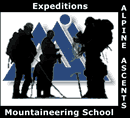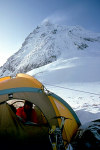Hello yet again, friends. This will be the final dispatch from base camp for the Alpine Ascents 2003 Mt. Everest Expedition. By the time you read this, Everest Base Camp will no longer exist. Only a few rock walls will remain, all of which will secumb to glacier movement and fall over by the end of summer.
Yet again on Chomolungma (Mt. Everest), patience has paid off. Through a season of very difficult weather, and some very nice as well as very difficult people at Base Camp, it is at times hard to maintain one's focus on the expedition. People's natural inclination is to push on and get it over with. As a consequence of that attitude this year, we had to watch several waves of potential summitters swarm up the mountain, and during this it is hard to restrain oneself even knowing that they were climbing into poor conditions. When these same climbers returned down again with many more unsuccessful climbers and frostbitten digits than summitters, it becomes a little clearer to understand what we are waiting for. Good weather.
During the long period we spent waiting for this illusive good weather, there was also tragedy on the mountain. Alpine Ascents personnel participated in two attempted rescues of members of other groups. Unfortunately both of these people died on the mountain. Death by stupidity in my humble opinion. It really doesn't matter what the medical cause of death was, when proactive action could have easily saved a life, it is death by stupidity. In one case (already well reported), a Sherpa was sick for several days. Instead of seeking medical care at a lower elevation, he chose to remain high and a tragedy resulted. In the other case, an unroped Indian army climber died in a crevasse fall. That is what climbing ropes are traditionally used to prevent in glacier climbing. Yet another meaningless tragedy for our sport, and for the family and friends of the victim. Also a tragedy, was the number of people, especially from base camp, uninterested in assisting with trying to save another human being's life. I wonder a lot if there is any connection with the bad weather we experienced etc., and the bad and selfish attitude many foreign visitors to the mountain displayed this year.
Lack of teamwork was also a big problem among many parties this season. It was a sad thing for me to observe many climbers' hopes and dreams of the summit dashed by lack of experienced support on the mountain and infighting and discord amongst team members. One would hope that by the time a climber attains the experience to be able to attempt Mt. Everest, such behavior would be behind them.
Also an MI-17 helicopter crash at base camp highlighted the dangers of rotor-wing flight at this altitude. This unfortunate incident left 2 dead and several seriously injured. People get rather blase about flying here and there, without thinking of the consequences. If the same crash had occured three or four days earlier, it would have taken out several dozen tents and people. I hope the Ministry of Civil Aviation here will now ban all but emergency flights to base camp. We were getting as many as 4 or more flights a day with some expeditions ordering re-supplies by helicopter. If this doesn't stop, it is only a matter of time until one is crashed right in the middle of base camp, mid-season, with a result of several hundred casualties possible.
On the positive side, many new friends were made by all here, as always. And there were some amazing things accomplished. A summit climb from base camp in around 12 hours and 40 minutes. Then another in around 10 hours and 40 or so minutes, both by Sherpa climbers. On the rescue front, I'd personally like to give credit once again to the Argentinean brothers Willie and Damian Benagas. After spending six days completing an impressive and difficult new route on the north buttress of Nuptse, they then were involved in two rescue attempts. The attempt to bring through the Khumbu Icefall of the critically ill Sherpa, and later the rescue effort of the passengers of the MI-17 helocopter which crashed in base camp. Of all the western visitors climbing Chomolungma here this season, they are by far the karma accumulating winners, and the entire climbing community should thank them for their untiring effort on behalf of fellow climbers (not to mention upping the ante on high altitiude technical climbing in the Himalaya!).
Another highlight (I think. . .) is the new slow record of 11 hours to descend the Lhotse Face from Camp 4 to Camp 2 by Paul Obert and Willi Prittie. This is usually a 4 to 6 hour descent. There must be some kind of award available somewhere for this feat. . .
Yesterday's descent through the Khumbu Icefall for the final time, went without a hitch (thank goodness). With the very warm pre-monsoon weather also comes an accelleration of ice movement. Dozens of icefalls (ice avalanches) now occur per day all around us, and a half an hour hardly goes by without groaning, popping, snapping, rumbling, or actual sensable motion of the glacier under our feet. While we were descending the icefall, there were two very large collapses of seracs (luckily not near us), and many places in the icefall which have looked the same all season were not recognizeable upon descent. All this makes a climber a little nervous when he still has to go through it one more time.
A high point of the descent yesterday, was the icefall route crew removing ladders, ropes, and anchors right behind us. Today, the disassembly of base camp is happening right around me as I write this. All expedition members are en route walking out as of this morning. The only thing left now is to load the yaks and walk out. Oh, I forgot the BIG Sherpa party on the way out. . .
Well, it's over now. And by being patient we had a superb summit day with almost no wind and the kind of unlimited views only available from the highest mountain in the world. No frostbite, no injuries, and a respectful deference to Chomolungma and Mialangsangma later, we call our expedition a success. We leave the mountain with an intense shared experience which will cement friendships for life.
— Willi Prittie, Alpine Ascents International Guide and MountainZone.com Correspondent



